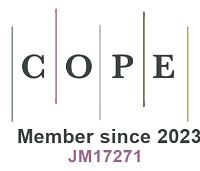REFERENCES
1. Thompson RC. Microplastics in the marine environment: sources, consequences and solutions. In: Bergmann M, Gutow L, Klages M, editors. Marine Anthropogenic Litter. Springer, Cham; 2015. p. 185-200.
2. He B, Liu A, Duan H, Wijesiri B, Goonetilleke A. Risk associated with microplastics in urban aquatic environments: a critical review. J Hazard Mater 2022;439:129587.
3. Boucher J, Friot D. 2017. Primary microplastics in the oceans: a global evaluation of sources. Gland, Switzerland: Iucn;2017. p.43.
4. Clark JR, Cole M, Lindeque PK, et al. Marine microplastic debris: a targeted plan for understanding and quantifying interactions with marine life. Front Ecol Environ 2016;14:317-24.
5. Ma B, Xue W, Hu C, Liu H, Qu J, Li L. Characteristics of microplastic removal via coagulation and ultrafiltration during drinking water treatment. Chem Eng J 2019;359:159-67.
6. Elgarahy AM, Akhdhar A, Elwakeel KZ. Microplastics prevalence, interactions, and remediation in the aquatic environment: a critical review. J Environ Chem Eng 2021;9:106224.
7. Barhoumi B, Sander SG, Tolosa I. A review on per- and polyfluorinated alkyl substances (PFASs) in microplastic and food-contact materials. Environ Res 2022;206:112595.
8. Issac MN, Kandasubramanian B. Effect of microplastics in water and aquatic systems. Environ Sci Pollut Res Int 2021;28:19544-62.
9. Wu X, Zhao X, Chen R, et al. Wastewater treatment plants act as essential sources of microplastic formation in aquatic environments: a critical review. Water Res 2022;221:118825.
10. Scott JW, Gunderson KG, Green LA, Rediske RR, Steinman AD. Perfluoroalkylated substances (PFAS) associated with microplastics in a lake environment. Toxics 2021;9:106.
11. Daly ER, Chan BP, Talbot EA, et al. Per- and polyfluoroalkyl substance (PFAS) exposure assessment in a community exposed to contaminated drinking water, New Hampshire, 2015. Int J Hyg Environ Health 2018;221:569-77.
12. Lu D, Sha S, Luo J, Huang Z, Zhang Jackie X. Treatment train approaches for the remediation of per- and polyfluoroalkyl substances (PFAS): a critical review. J Hazard Mater 2020;386:121963.
13. Herzke D, Olsson E, Posner S. Perfluoroalkyl and polyfluoroalkyl substances (PFASs) in consumer products in Norway-a pilot study. Chemosphere 2012;88:980-7.
14. Prevedouros K, Cousins IT, Buck RC, Korzeniowski SH. Sources, fate and transport of perfluorocarboxylates. Environ Sci Technol 2006;40:32-44.
15. Lau C, Anitole K, Hodes C, Lai D, Pfahles-Hutchens A, Seed J. Perfluoroalkyl acids: a review of monitoring and toxicological findings. Toxicol Sci 2007;99:366-94.
16. Peden-Adams MM, Keller JM, Eudaly JG, Berger J, Gilkeson GS, Keil DE. Suppression of humoral immunity in mice following exposure to perfluorooctane sulfonate. Toxicol Sci 2008;104:144-54.
17. Suja F, Pramanik BK, Zain SM. Contamination, bioaccumulation and toxic effects of perfluorinated chemicals (PFCs) in the water environment: a review paper. Water Sci Technol 2009;60:1533-44.
18. Bakir A, Rowland SJ, Thompson RC. Enhanced desorption of persistent organic pollutants from microplastics under simulated physiological conditions. Environ Pollut 2014;185:16-23.
19. Meng L, Tian H, Lv J, Wang Y, Jiang G. Influence of microplastics on the photodegradation of perfluorooctane sulfonamide (FOSA). J Environ Sci 2023;127:791-8.
20. Alimi OS, Farner Budarz J, Hernandez LM, Tufenkji N. Microplastics and nanoplastics in aquatic environments: aggregation, deposition, and enhanced contaminant transport. Environ Sci Technol 2018;52:1704-24.
21. Buck RC, Franklin J, Berger U, et al. Perfluoroalkyl and polyfluoroalkyl substances in the environment: terminology, classification, and origins. Integr Environ Assess Manag 2011;7:513-41.
22. Wang F, Shih KM, Li XY. The partition behavior of perfluorooctanesulfonate (PFOS) and perfluorooctanesulfonamide (FOSA) on microplastics. Chemosphere 2015;119:841-7.
23. Cormier B, Borchet F, Kärrman A, Szot M, Yeung LWY, Keiter SH. Sorption and desorption kinetics of PFOS to pristine microplastic. Environ Sci Pollut Res Int 2022;29:4497-507.
24. Yan M, Wang L, Dai Y, Sun H, Liu C. Behavior of Microplastics in Inland Waters: Aggregation, Settlement, and Transport. Bull Environ Contam Toxicol 2021;107:700-9.
25. Antunes JC, Frias JGL, Micaelo AC, Sobral P. Resin pellets from beaches of the Portuguese coast and adsorbed persistent organic pollutants. Estuar Coast Shelf S 2013;130:62-9.
26. Jha G, Kankarla V, Mclennon E, et al. Per- and polyfluoroalkyl substances (PFAS) in integrated crop-livestock systems: environmental exposure and human health risks. Int J Environ Res Public Health 2021;18:12550.
27. Sobhani Z, Fang C, Naidu R, Megharaj M. Microplastics as a vector of toxic chemicals in soil: enhanced uptake of perfluorooctane sulfonate and perfluorooctanoic acid by earthworms through sorption and reproductive toxicity. Environ Technol Inno 2021;22:101476.
28. Kang P, Zhao Y, Zuo C, et al. The unheeded inherent connections and overlap between microplastics and poly- and perfluoroalkyl substances: a comprehensive review. Sci Total Environ 2023;878:163028.
29. Nguyen HT, McLachlan MS, Tscharke B, et al. Background release and potential point sources of per- and polyfluoroalkyl substances to municipal wastewater treatment plants across Australia. Chemosphere 2022;293:133657.
30. Shan W, Li B, Zhang H, et al. Distribution, characteristics and daily fluctuations of microplastics throughout wastewater treatment plants with mixed domestic-industrial influents in Wuxi City, China. Front Environ Sci Eng 2022;16:6.
31. Ateia M, Ersan G, Alalm MG, Boffito DC, Karanfil T. Emerging investigator series: microplastic sources, fate, toxicity, detection, and interactions with micropollutants in aquatic ecosystems-a review of reviews. Environ Sci Process Impacts 2022;24:172-95.
32. Schellenberger S, Liagkouridis I, Awad R, et al. An outdoor aging study to investigate the release of per- and polyfluoroalkyl substances (PFAS) from functional textiles. Environ Sci Technol 2022;56:3471-9.
33. Enyoh CE, Wang Q, Wang W, et al. Sorption of per- and polyfluoroalkyl substances (PFAS) using polyethylene (PE) microplastics as adsorbent: grand canonical monte carlo and molecular dynamics (GCMC-MD) studies. Int J Environ An Ch 2022;Epub ahead of print.
34. Gremmel C, Frömel T, Knepper TP. Systematic determination of perfluoroalkyl and polyfluoroalkyl substances (PFASs) in outdoor jackets. Chemosphere 2016;160:173-80.
35. Hu XC, Dai M, Sun JM, Sunderland EM. The utility of machine learning models for predicting chemical contaminants in drinking water: promise, challenges, and opportunities. Curr Environ Health Rep 2023;10:45-60.
36. He YJ, Qin Y, Zhang TL, et al. Migration of (non-) intentionally added substances and microplastics from microwavable plastic food containers. J Hazard Mater 2021;417:126074.
37. Luo Y, Gibson CT, Chuah C, Tang Y, Naidu R, Fang C. Raman imaging for the identification of teflon microplastics and nanoplastics released from non-stick cookware. Sci Total Environ 2022;851:158293.
38. Paragot N, Bečanová J, Karásková P, et al. Multi-year atmospheric concentrations of per- and polyfluoroalkyl substances (PFASs) at a background site in central Europe. Environ Pollut 2020;265:114851.
39. Meng L, Song B, Zhong H, et al. Legacy and emerging per- and polyfluoroalkyl substances (PFAS) in the Bohai Sea and its inflow rivers. Environ Int 2021;156:106735.
40. Ng K, Alygizakis N, Androulakakis A, et al. Target and suspect screening of 4777 per- and polyfluoroalkyl substances (PFAS) in river water, wastewater, groundwater and biota samples in the Danube River Basin. J Hazard Mater 2022;436:129276.
41. Yan H, Cousins IT, Zhang C, Zhou Q. Perfluoroalkyl acids in municipal landfill leachates from China: occurrence, fate during leachate treatment and potential impact on groundwater. Sci Total Environ 2015;524-525:23-31.
42. Wan Y, Chen X, Liu Q, Hu H, Wu C, Xue Q. Informal landfill contributes to the pollution of microplastics in the surrounding environment. Environ Pollut 2022;293:118586.
43. Ziajahromi S, Neale PA, Telles Silveira I, Chua A, Leusch FDL. An audit of microplastic abundance throughout three Australian wastewater treatment plants. Chemosphere 2021;263:128294.
44. Houtz EF, Sutton R, Park JS, Sedlak M. Poly- and perfluoroalkyl substances in wastewater: Significance of unknown precursors, manufacturing shifts, and likely AFFF impacts. Water Res 2016;95:142-9.
45. Liu K, Wang X, Fang T, Xu P, Zhu L, Li D. Source and potential risk assessment of suspended atmospheric microplastics in Shanghai. Sci Total Environ 2019;675:462-71.
46. Lu Z, Lu R, Zheng H, et al. Risk exposure assessment of per- and polyfluoroalkyl substances (PFASs) in drinking water and atmosphere in central eastern China. Environ Sci Pollut Res 2018;25:9311-20.
47. Jenner LC, Sadofsky LR, Danopoulos E, Rotchell JM. Household indoor microplastics within the Humber region (United Kingdom): quantification and chemical characterisation of particles present. Atmos Environ 2021;259:118512.
48. Goosey E, Harrad S. Perfluoroalkyl substances in UK indoor and outdoor air: spatial and seasonal variation, and implications for human exposure. Environ Int 2012;45:86-90.
49. Choi H, Lee I, Kim H, et al. Comparison of microplastic characteristics in the indoor and outdoor air of urban areas of South Korea. Water Air Soil Pollut 2022;233:169.
50. Kim SK, Shoeib M, Kim KS, Park JE. Indoor and outdoor poly- and perfluoroalkyl substances (PFASs) in Korea determined by passive air sampler. Environ Pollut 2012;162:144-50.
51. Liu M, Lu S, Song Y, et al. Microplastic and mesoplastic pollution in farmland soils in suburbs of Shanghai, China. Environ Pollut 2018;242:855-62.
52. Zhu Q, Qian J, Huang S, et al. Occurrence, distribution, and input pathways of per- and polyfluoroalkyl substances in soils near different sources in Shanghai. Environ Pollut 2022;308:119620.
53. Zhou Q, Zhang H, Fu C, et al. The distribution and morphology of microplastics in coastal soils adjacent to the Bohai Sea and the Yellow Sea. Geoderma 2018;322:201-8.
55. Pan Y, Zhang H, Cui Q, et al. Worldwide distribution of novel perfluoroether carboxylic and sulfonic acids in surface water. Environ Sci Technol 2018;52:7621-9.
56. Fan Y, Zheng K, Zhu Z, Chen G, Peng X. Distribution, sedimentary record, and persistence of microplastics in the Pearl River catchment, China. Environ Pollut 2019;251:862-70.
57. Jin YH, Liu W, Sato I, et al. PFOS and PFOA in environmental and tap water in China. Chemosphere 2009;77:605-11.
58. Zhang W, Zhang S, Wang J, et al. Microplastic pollution in the surface waters of the Bohai Sea, China. Environ Pollut 2017;231:541-8.
59. Zhao Z, Tang J, Mi L, et al. Perfluoroalkyl and polyfluoroalkyl substances in the lower atmosphere and surface waters of the Chinese Bohai Sea, Yellow Sea, and Yangtze River estuary. Sci Total Environ 2017;599-600:114-23.
60. Xiong X, Zhang K, Chen X, Shi H, Luo Z, Wu C. Sources and distribution of microplastics in China’s largest inland lake-Qinghai Lake. Environ Pollut 2018;235:899-906.
61. Yu L, Liu X, Hua Z. Occurrence, distribution, and risk assessment of perfluoroalkyl acids in drinking water sources from the lower Yangtze River. Chemosphere 2022;287:132064.
62. Lusher AL, Burke A, O’Connor I, Officer R. Microplastic pollution in the Northeast Atlantic Ocean: validated and opportunistic sampling. Mar Pollut Bull 2014;88:325-33.
63. Miranda DA, Leonel J, Benskin JP, Johansson J, Hatje V. Perfluoroalkyl substances in the western tropical atlantic ocean. Environ Sci Technol 2021;55:13749-58.
64. Fuschi C, Pu H, Macdonell M, Picel K, Negri M, Chen J. Microplastics in the great lakes: environmental, health, and socioeconomic implications and future directions. ACS Sustainable Chem Eng 2022;10:14074-91.
65. Boulanger B, Vargo J, Schnoor JL, Hornbuckle KC. Detection of perfluorooctane surfactants in Great Lakes water. Environ Sci Technol 2004;38:4064-70.
66. Mani T, Burkhardt-Holm P. Seasonal microplastics variation in nival and pluvial stretches of the Rhine River-from the swiss catchment towards the North Sea. Sci Total Environ 2020;707:135579.
67. Möller A, Ahrens L, Surm R, et al. Distribution and sources of polyfluoroalkyl substances (PFAS) in the River Rhine watershed. Environ Pollut 2010;158:3243-50.
68. Botterell ZLR, Bergmann M, Hildebrandt N, et al. Microplastic ingestion in zooplankton from the Fram Strait in the Arctic. Sci Total Environ 2022;831:154886.
69. Sun X, Liang J, Zhu M, Zhao Y, Zhang B. Microplastics in seawater and zooplankton from the Yellow Sea. Environ Pollut 2018;242:585-95.
70. Desforges JP, Galbraith M, Ross PS. Ingestion of microplastics by zooplankton in the northeast pacific ocean. Arch Environ Contam Toxicol 2015;69:320-30.
71. Lam NH, Cho CR, Lee JS, et al. Perfluorinated alkyl substances in water, sediment, plankton and fish from Korean rivers and lakes: a nationwide survey. Sci Total Environ 2014;491-492:154-62.
72. Li X, Yin Yeung LW, Xu M, et al. Perfluorooctane sulfonate (PFOS) and other fluorochemicals in fish blood collected near the outfall of wastewater treatment plant (WWTP) in Beijing. Environ Pollut 2008;156:1298-303.
73. Casal P, González-Gaya B, Zhang Y, et al. Accumulation of perfluoroalkylated substances in oceanic plankton. Environ Sci Technol 2017;51:2766-75.
74. Naidu BC, Xavier KAM, Shukla SP, Jaiswar AK, Nayak BB. Microplastics in the foreshore coastal waters, sediment, and coastal fauna of a highly populated megacity-a study on the effect of anthropogenic discharge on clams. Mar Pollut Bull 2022;185:114262.
75. Ben-Haddad M, Abelouah MR, Hajji S, et al. The wedge clam Donax trunculus L., 1758 as a bioindicator of microplastic pollution. Mar Pollut Bull 2022;178:113607.
76. Guo M, Zheng G, Peng J, et al. Distribution of perfluorinated alkyl substances in marine shellfish along the Chinese Bohai Sea coast. J Environ Sci Health B 2019;54:271-80.
77. Wu Y, Wang Y, Li J, et al. Perfluorinated compounds in seafood from coastal areas in China. Environ Int 2012;42:67-71.
78. Haque MR, Ali MM, Ahmed W, et al. Assessment of microplastics pollution in aquatic species (fish, crab, and snail), water, and sediment from the Buriganga River, Bangladesh: an ecological risk appraisals. Sci Total Environ 2023;857:159344.
79. Gao S, Yan K, Liang B, Shu R, Wang N, Zhang S. The different ways microplastics from the water column and sediment accumulate in fish in Haizhou Bay. Sci Total Environ 2022;854:158575.
80. Wang F, Yu Y, Wu H, et al. Microplastics in spotted seal cubs (Phoca largha): Digestion after ingestion? Sci Total Environ 2021;785:147426.
81. Philipp C, Unger B, Siebert U. Occurrence of microplastics in harbour seals (Phoca vitulina) and Grey Seals (Halichoerus grypus) from German Waters. Animals 2022;12:551.
82. Sedlak MD, Benskin JP, Wong A, Grace R, Greig DJ. Per- and polyfluoroalkyl substances (PFASs) in San Francisco Bay wildlife: temporal trends, exposure pathways, and notable presence of precursor compounds. Chemosphere 2017;185:1217-26.
83. Boisvert G, Sonne C, Rigét FF, Dietz R, Letcher RJ. Bioaccumulation and biomagnification of perfluoroalkyl acids and precursors in east Greenland polar bears and their ringed seal prey. Environ Pollut 2019;252:1335-43.
84. Zhang X, Lohmann R, Sunderland EM. Poly- and perfluoroalkyl substances in seawater and plankton from the northwestern atlantic margin. Environ Sci Technol 2019;53:12348-56.
85. Silvestrova K, Stepanova N. The distribution of microplastics in the surface layer of the Atlantic Ocean from the subtropics to the equator according to visual analysis. Mar Pollut Bull 2021;162:111836.
86. Zhao Z, Xie Z, Tang J, et al. Seasonal variations and spatial distributions of perfluoroalkyl substances in the rivers Elbe and lower Weser and the North Sea. Chemosphere 2015;129:118-25.
87. Kahkashan S, Wang X, Chen J, et al. Concentration, distribution and sources of perfluoroalkyl substances and organochlorine pesticides in surface sediments of the northern Bering Sea, Chukchi Sea and adjacent Arctic Ocean. Chemosphere 2019;235:959-68.
88. Mu J, Zhang S, Qu L, et al. Microplastics abundance and characteristics in surface waters from the Northwest Pacific, the Bering Sea, and the Chukchi Sea. Mar Pollut Bull 2019;143:58-65.
89. Yamashita N, Kannan K, Taniyasu S, Horii Y, Petrick G, Gamo T. A global survey of perfluorinated acids in oceans. Mar Pollut Bull 2005;51:658-68.
90. Dai Z, Zhang H, Zhou Q, et al. Occurrence of microplastics in the water column and sediment in an inland sea affected by intensive anthropogenic activities. Environ Pollut 2018;242:1557-65.
91. Liu Y, Zhang Y, Li J, Wu N, Li W, Niu Z. Distribution, partitioning behavior and positive matrix factorization-based source analysis of legacy and emerging polyfluorinated alkyl substances in the dissolved phase, surface sediment and suspended particulate matter around coastal areas of Bohai Bay, China. Environ Pollut 2019;246:34-44.
92. Dubaish F, Liebezeit G. Suspended microplastics and black carbon particles in the jade system, Southern North Sea. Water Air Soil Pollut 2013;224:1352.
93. Duan Z, Zhao S, Zhao L, et al. Microplastics in Yellow River Delta wetland: occurrence, characteristics, human influences, and marker. Environ Pollut 2020;258:113232.
94. Zhao P, Xia X, Dong J, et al. Short- and long-chain perfluoroalkyl substances in the water, suspended particulate matter, and surface sediment of a turbid river. Sci Total Environ 2016;568:57-65.
95. Hu L, Chernick M, Hinton DE, Shi H. Microplastics in small waterbodies and tadpoles from Yangtze River Delta, China. Environ Sci Technol 2018;52:8885-93.
96. Pan CG, Zhao JL, Liu YS, et al. Bioaccumulation and risk assessment of per- and polyfluoroalkyl substances in wild freshwater fish from rivers in the Pearl River Delta region, South China. Ecotoxicol Environ Saf 2014;107:192-9.
97. Lin L, Zuo LZ, Peng JP, et al. Occurrence and distribution of microplastics in an urban river: a case study in the Pearl River along Guangzhou City, China. Sci Total Environ 2018;644:375-81.
98. Mani T, Blarer P, Storck FR, Pittroff M, Wernicke T, Burkhardt-Holm P. Repeated detection of polystyrene microbeads in the Lower Rhine River. Environ Pollut 2019;245:634-41.
99. Su H, Lu Y, Wang P, et al. Perfluoroalkyl acids (PFAAs) in indoor and outdoor dusts around a mega fluorochemical industrial park in China: implications for human exposure. Environ Int 2016;94:667-73.
100. Sun Z, Zhang C, Yan H, et al. Spatiotemporal distribution and potential sources of perfluoroalkyl acids in Huangpu River, Shanghai, China. Chemosphere 2017;174:127-35.
101. Abunada Z, Alazaiza MYD, Bashir MJK. An overview of per- and polyfluoroalkyl substances (PFAS) in the environment: source, fate, risk and regulations. Water 2020;12:3590.
102. Mejías C, Martín J, Santos JL, Aparicio I, Alonso E. Adsorption of perfluoroalkyl substances on polyamide microplastics: Effect of sorbent and influence of environmental factors. Environ Res 2023;216:114834.
103. Joo SH, Liang Y, Kim M, Byun J, Choi H. Microplastics with adsorbed contaminants: mechanisms and treatment. Environ Chall 2021;3:100042.
104. Higgins CP, Luthy RG. Sorption of perfluorinated surfactants on sediments. Environ Sci Technol 2006;40:7251-6.
105. Xiao F, Jin B, Golovko SA, Golovko MY, Xing B. Sorption and desorption mechanisms of cationic and zwitterionic per- and polyfluoroalkyl substances in natural soils: thermodynamics and hysteresis. Environ Sci Technol 2019;53:11818-27.
106. Oliver DP, Li Y, Orr R, et al. Sorption behaviour of per- and polyfluoroalkyl substances (PFASs) in tropical soils. Environ Pollut 2020;258:113726.
107. Carbery M, O'Connor W, Palanisami T. Trophic transfer of microplastics and mixed contaminants in the marine food web and implications for human health. Environ Int 2018;115:400-9.
108. Mato Y, Isobe T, Takada H, Kanehiro H, Ohtake C, Kaminuma T. Plastic resin pellets as a transport medium for toxic chemicals in the marine environment. Environ Sci Technol 2001;35:318-24.
109. Stapleton MJ, Ansari AJ, Hai FI. Antibiotic sorption onto microplastics in water: A critical review of the factors, mechanisms and implications. Water Res 2023;233:119790.
110. Tourinho PS, Kočí V, Loureiro S, van Gestel CAM. Partitioning of chemical contaminants to microplastics: sorption mechanisms, environmental distribution and effects on toxicity and bioaccumulation. Environ Pollut 2019;252:1246-56.
111. Atugoda T, Vithanage M, Wijesekara H, et al. Interactions between microplastics, pharmaceuticals and personal care products: Implications for vector transport. Environ Int 2021;149:106367.
112. Pascall MA, Zabik ME, Zabik MJ, Hernandez RJ. Uptake of polychlorinated biphenyls (PCBs) from an aqueous medium by polyethylene, polyvinyl chloride, and polystyrene films. J Agric Food Chem 2005;53:164-9.
113. Karapanagioti HK, Klontza I. Testing phenanthrene distribution properties of virgin plastic pellets and plastic eroded pellets found on Lesvos island beaches (Greece). Mar Environ Res 2008;65:283-90.
114. Corcoran PL, Belontz SL, Ryan K, Walzak MJ. Factors controlling the distribution of microplastic particles in benthic sediment of the thames river, Canada. Environ Sci Technol 2020;54:818-25.
115. Guzzetti E, Sureda A, Tejada S, Faggio C. Microplastic in marine organism: environmental and toxicological effects. Environ Toxicol Pharmacol 2018;64:164-71.
116. Fu L, Li J, Wang G, Luan Y, Dai W. Adsorption behavior of organic pollutants on microplastics. Ecotoxicol Environ Saf 2021;217:112207.
117. Mei W, Sun H, Song M, et al. Per- and polyfluoroalkyl substances (PFASs) in the soil-plant system: sorption, root uptake, and translocation. Environ Int 2021;156:106642.
118. Gagliano E, Sgroi M, Falciglia PP, Vagliasindi FGA, Roccaro P. Removal of poly- and perfluoroalkyl substances (PFAS) from water by adsorption: role of PFAS chain length, effect of organic matter and challenges in adsorbent regeneration. Water Res 2020;171:115381.
119. Bhagat J, Nishimura N, Shimada Y. Toxicological interactions of microplastics/nanoplastics and environmental contaminants: current knowledge and future perspectives. J Hazard Mater 2021;405:123913.
120. Yang H, Lai H, Huang J, et al. Polystyrene microplastics decrease F-53B bioaccumulation but induce inflammatory stress in larval zebrafish. Chemosphere 2020;255:127040.
121. Fitzgerald NJM, Simcik MF, Novak PJ. Perfluoroalkyl substances increase the membrane permeability and quorum sensing response in
122. Kim YR, Kim MA, Cho HJ, et al. Galangin prevents aminoglycoside-induced ototoxicity by decreasing mitochondrial production of reactive oxygen species in mouse cochlear cultures. Toxicol Lett 2016;245:78-85.
123. Chen W, Yuan D, Shan M, Yang Z, Liu C. Single and combined effects of amino polystyrene and perfluorooctane sulfonate on hydrogen-producing thermophilic bacteria and the interaction mechanisms. Sci Total Environ 2020;703:135015.
124. Rainieri S, Conlledo N, Larsen BK, Granby K, Barranco A. Combined effects of microplastics and chemical contaminants on the organ toxicity of zebrafish (danio rerio). Environ Res 2018;162:135-43.
125. Álvarez-Ruiz R, Picó Y, Campo J. Bioaccumulation of emerging contaminants in mussel (mytilus galloprovincialis): influence of microplastics. Sci Total Environ 2021;796:149006.
126. Islam N, Garcia da Fonseca T, Vilke J, et al. Perfluorooctane sulfonic acid (PFOS) adsorbed to polyethylene microplastics: accumulation and ecotoxicological effects in the clam Scrobicularia plana. Mar Environ Res 2021;164:105249.
127. Chen CC, Shi Y, Zhu Y, et al. Combined toxicity of polystyrene microplastics and ammonium perfluorooctanoate to Daphnia magna: mediation of intestinal blockage. Water Res 2022;219:118536.
128. Lee H, Lee HJ, Kwon JH. Estimating microplastic-bound intake of hydrophobic organic chemicals by fish using measured desorption rates to artificial gut fluid. Sci Total Environ 2019;651:162-70.
129. Liu Y, Shi Q, Liu X, Wang L, He Y, Tang J. Perfluorooctane sulfonate (PFOS) enhanced polystyrene particles uptake by human colon adenocarcinoma Caco-2 cells. Sci Total Environ 2022;848:157640.







